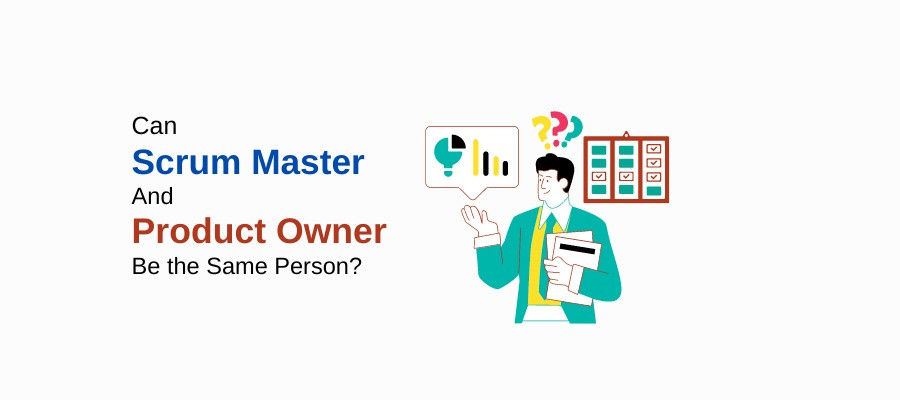Can Scrum Master And Product Owner Be the Same Person?

Although the roles of a Scrum Master and a Product Owner are distinct, some teams often do not have both. Either they have a single Agile Leader, or the Scrum Master is covering up for the Product Owner and vice versa. Any such situation might be the reason for the poor performance and productivity of the Agile teams. Now the question arises: Can the Scrum Master and Product Owner be the same person? Is it a healthy practice in Agile Project Management? That’s what we are about to find out through today’s discussion!
The Case Of A Single Agile Leader-Driven Team: Industries and Projects That Might Benefit
Depending on the project dynamics and team structure, having a single Agile Leader performing both roles of a Scrum Master and Product Owner can be feasible and even beneficial. Notably, it can be helpful in small teams or projects with limited resources and the following scenarios:
- Startup Environments: In startup settings where resources are scarce, having a single person fulfill both roles can enhance agility and flexibility. Startups often require rapid decision-making and adaptability, making a dual-role Agile leader an asset.
- Non-Commercial Projects: Projects undertaken for internal improvements or community initiatives may not require the same level of specialization in roles. A single Agile leader can efficiently drive project progress while ensuring alignment with organizational goals.
- Research and Development: R&D projects often involve exploratory work and fast-paced iterations. In such environments, a combined role can facilitate seamless collaboration between development teams and stakeholders, leading to quicker innovation.
However, is it a good practice to follow? The next section will cover the repercussions of having a single Agile Leader to drive the entire team!
Scenario 1: Benefits Of Having A Scrum Master Playing The Role Of A Product Owner:
- Streamlined Decision-Making: With one person handling both roles, decision-making processes can be expedited, leading to faster progress and adaptability.
- Deep Understanding of Project Goals: The Agile leader can comprehensively understand the Scrum framework and the customer's needs, facilitating better alignment between project objectives and stakeholder requirements.
- Reduced Communication Overhead: Consolidating roles can minimize communication overhead within the team, as there's a single point of contact for both process-related queries and product-related decisions.
Scenario 2: Benefits Of Having A Product Owner Playing The Role Of A Scrum Master:
- Holistic Project Oversight: The Product Owner, acting as the Scrum Master, can provide holistic oversight of project goals and team dynamics, ensuring alignment between product vision and development efforts.
- Enhanced Customer Focus: With the Product Owner taking on the Scrum Master role, there's a greater emphasis on customer needs and feedback during the Agile process, leading to more customer-centric deliverables.
- Efficient Resource Utilization: By combining roles, the team can optimize resource utilization and avoid duplicative efforts, improving efficiency and productivity.
What Agile Teams Might Miss Without Separate Roles?
While combining the roles of Scrum Master and Product Owner can offer advantages in specific scenarios, it's essential to acknowledge the potential drawbacks and areas where Agile teams might miss out:
- Diluted Focus: Without dedicated individuals for each role, there's a risk of diluting the focus on either facilitating the Scrum process or representing the customer's interests. This could lead to blurred priorities and compromised project outcomes.
- Conflicting Responsibilities: The responsibilities of a Scrum Master and a Product Owner can sometimes conflict, especially when it comes to prioritizing tasks and managing stakeholder expectations. A single person juggling both roles may struggle to navigate these conflicts effectively.
- Limited Perspective: Each role brings a unique perspective to the Agile team. While the Scrum Master focuses on process improvement and team dynamics, the Product Owner advocates for the customer's needs and market requirements. Combining these roles may result in a narrower view of project requirements and stakeholder feedback.
- Lack of Sincerity: Without separate individuals overseeing the Scrum practices and representing the customer's interests, critical feedback loops and accountability mechanisms could be overlooked, potentially compromising project outcomes.
Thus, Agile teams might suffer with a single Scrum Master or Product Owner. They might underperform and fail to deliver their Project Objectives within the pre-confirmed delivery timeline!
Finding the Right Balance:
While a single individual can fulfill the roles of both Scrum Master and Product Owner, it's crucial to assess the specific needs of the project and team before making such a decision. Merging these roles can sometimes enhance efficiency and agility, especially in resource-constrained environments. However, Agile teams should be mindful of the potential trade-offs and maintain a balance between process facilitation and customer-centricity for project success.
Reference:
https://www.scrum.org/resources/blog/can-product-owner-also-be-scrum-master
https://www.forbes.com/advisor/education/business-and-marketing/scrum-master-vs-product-owner/



